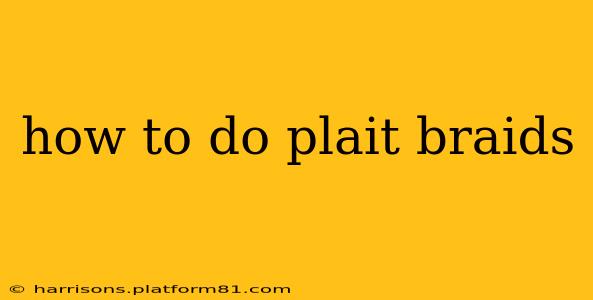Plait braids, also known as three-strand braids, are a fundamental hairstyle with endless variations. Whether you're a braiding novice or looking to refine your technique, this guide will walk you through the process step-by-step, addressing common questions and offering helpful tips.
Getting Started: What You'll Need
Before you begin, gather your essentials:
- A mirror: Essential for seeing what you're doing, especially at the back of your head.
- A hairbrush or comb: To detangle your hair and create neat sections.
- Hair ties: To secure the braid at the end.
- Optional: Hair clips or elastics: To section off hair and keep it out of the way.
- Optional: Hair products: A detangling spray, leave-in conditioner, or hair oil can make the process smoother, especially with thick or unruly hair.
Step-by-Step Guide to a Basic Plait Braid
-
Prep your hair: Brush or comb your hair thoroughly to remove any tangles or knots. This will prevent snags and make braiding much easier. If your hair is prone to frizz, consider applying a smoothing serum or oil.
-
Section your hair: Decide where you want to start your braid. For a standard braid, you'll usually start at the crown of your head. Gather a section of hair of the desired thickness—the thicker the section, the thicker the braid.
-
Divide into three strands: Divide the sectioned hair into three equal strands. Hold one strand in each hand, with one strand in the middle.
-
Begin braiding: Cross the right strand over the middle strand, so it becomes the new middle strand.
-
Continue braiding: Next, cross the left strand over the new middle strand (which was originally the right strand).
-
Repeat: Continue alternating, crossing the right strand over the middle, then the left strand over the middle, until you reach the end of your hair.
-
Secure the braid: Once you've reached the end, secure the braid with a hair tie.
Mastering Different Plait Braid Variations
Once you've mastered the basic plait braid, you can experiment with different variations:
- Dutch braids: Instead of braiding over the strands, you braid them underneath. This creates a raised, textured braid that sits on top of the scalp.
- French braids: These braids start at the crown of your head and incorporate new sections of hair as you braid down.
- Fishtail braids: This intricate braid involves only two strands, creating a unique, textured look.
- Waterfall braids: This romantic style incorporates sections of hair that fall freely from the braid as you continue braiding.
Troubleshooting Common Plait Braiding Problems
My braid is too loose.
This is usually caused by not pulling the strands tightly enough as you braid. Try pulling each strand tighter as you cross it over the middle strand.
My braid is uneven.
Ensure that you’re using equal-sized sections of hair from the beginning and maintaining consistent tension throughout the braiding process.
My hair is too short to braid.
Even short hair can be braided! Try using smaller sections or incorporating other hair styling techniques to create a cute braided look.
How long does it take to learn how to plait braid?
The time it takes to learn varies greatly depending on your dexterity and practice. Some people pick it up quickly, while others may take longer. Consistent practice is key!
What are the benefits of plaiting your hair?
Plaiting offers several benefits:
- Keeps hair neat and tidy: Great for workouts, everyday wear, or special occasions.
- Protects hair: Helps to reduce breakage and tangles, especially overnight.
- Versatile styling: Provides a base for many other hairstyles and accessories.
Conclusion
Plait braiding is a skill that improves with practice. Start with the basics, experiment with variations, and don't be afraid to get creative! With a little patience and persistence, you'll be creating beautiful braids in no time.
